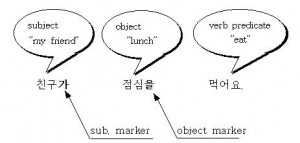Object marker –을 / –를
[Not many people are fond of talking about grammar. However, this is the least bit of the Korean grammar that you should know. We will be as plain as possible while discussing it.] An object in a sentence is the thing or a person that receives the action (described by the verb) from the subject. As we know, the subject is the doer (agent) of the action that the verb describes.
In this sentence, the doer of eating is “friend (‘my’ is assumed),” and the recipient of the action (“eating”) is “lunch.” As you might have noticed already, not every sentence will have both subject and object. Only those sentences containing verbs that take objects will. Let us think about English for a moment, in order to understand this grammatical terminology. In English grammar, the verbs that take objects are called ‘transitive verbs.’ For example, “to eat” is a transitive verb, since there must be something that is eaten (that is, receives the action). Similarly, you have a group of verbs that are transitive and another that are intransitive. Such verbs as “love, buy, drink, see, understand, choose, find…” are transitive. (What these verbs have in common is that you can say “to [verb] something / someone.”) Such verbs as “go, sit, stay, die, come…” are intransitive. You handle an object in an English sentence simply by placing it AFTER the verb.
|
A dog subject |
bites verb predicate |
a person. object |
If you switch the positions of the subject and the object, you get a completely different meaning.
|
A person subject |
bites verb predicate |
a dog. object |
Now, let’s go back to Korean. We know that the predicate must be placed at the of a sentence. Thus, both subject and object should come before the verb (predicate), and such change of meaning depending on the word order is less likely to happen. A subject does not necessarily come before the object in a Korean sentence. What clarifies the meaning, therefore, is the particle, i.e., subject/object markers. (Linguists usually call them Case markers.)
|
사람이 subject “a person” |
개를 object “a dog” |
물어요. verb predicate “bite” |
|
|
||
–이 and –를 are subject and object markers, respectively. Since the subject and object are labeled with markers, there is no possibility of confusion, as long as you keep them together.
|
개를 object “a dog” |
사람이 subject “a person” |
물어요. verb predicate “bite” |
|
|
||
The meaning can only change when you switch the markers.
|
사람을 object “a person” |
개가 subject “a dog” |
물어요. verb predicate “bite” |
|
|
||
Oftentimes, a subject is simply not said in Korean when it is understood.
A: 개가 누구를 물어요? (Who does the dog bite?)
B: 사람을 물어요. ([It] bites a person.)
As you might have noticed, the difference between –을 and –를 is purely phonological: when the previous syllable ends with a consonant (patch’im), use –을; with a vowel (no patch’im), use –를.
| 연습 <practice> |
You are given two nouns and one transitive verb in each line. Combine them into a sentence, assuming that the first noun is the subject and the second is the object. Be sure to conjugate the verb with –아요, –어요, -(으)세요, when needed.
Key
|
친구, (friend) |
텔레비, (television) |
보다 (watch, see) |
→ |
친구가 텔레비를 봐요. ([My] friend watches TV.) |
1. 남자친구 (boy friend), 책 (book), 사다 (buy)
2. 아버지 (father), 신문 (newspaper), 읽다 (read)
3. 학생 (student), 책, 읽다
4. 여자친구 (girl friend), 영화 (movie), 좋아하다 (like)
5. 할머니 (grandmother), 돈 (money), 주다 (give)
6. 아이 (child), 점심 (lunch), 먹다 (eat)
7. 친구, 남자친구, 만나다 (meet)
8. 삼촌 (uncle), 영어 (English), 공부하다 (study)
9. 여자친구, 한국어 (Korean), 공부하다
10. 어머니 (mother), 친구, 만나다

1 comment for “Korean lessons: Lesson 7”